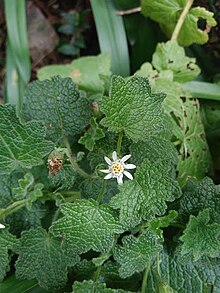Jungia is a genus of flowering plants in the family Asteraceae.[3][4] It is native mostly to South America, with one widespread species extending its range into Central America and southern Mexico.
| Jungia | |
|---|---|

| |
| Scientific classification | |
| Kingdom: | Plantae |
| Clade: | Tracheophytes |
| Clade: | Angiosperms |
| Clade: | Eudicots |
| Clade: | Asterids |
| Order: | Asterales |
| Family: | Asteraceae |
| Subfamily: | Mutisioideae |
| Tribe: | Nassauvieae |
| Genus: | Jungia L.f. 1781 conserved name, not Heist. ex Fabr. 1759 (Lamiaceae) nor Boehm. 1760 (Acanthaceae) nor Gaertn. 1788 (Myrtaceae) nor Loefl. 1758 (Malvaceae) nor Heist. ex Moench 1794 (Lamiaceae)[1] |
| Synonyms[2] | |
| |
Species accepted by the Plants of the World Online as of December 2022:[5]
- Jungia axillaris (Lag. ex DC.) Spreng. - Colombia
- Jungia beckii Harling - Bolivia
- Jungia calyculata Cuatrec. - Colombia
- Jungia coarctata Hieron. - Colombia, Ecuador
- Jungia crenatifolia Harling
- Jungia discolor Muschl.
- Jungia ferruginea L.f. - from Chiapas to Bolivia
- Jungia fistulosa Hieron.
- Jungia floribunda Less. - from Peru to Uruguay
- Jungia glandulifera Harling
- Jungia gracilis Harling - Peru
- Jungia gunnerifolia (S.Díaz) Diazgr. & F.Ávila
- Jungia hirsuta Cuatrec.
- Jungia karstenii Sch.Bip. ex Cuatrec. - Colombia
- Jungia mitis Benoist - Ecuador
- Jungia ovata Harling
- Jungia paniculata (DC.) A.Gray - Peru, Ecuador
- Jungia pauciflora Rusby - northwestern Argentina, Bolivia
- Jungia polita Griseb. - Bolivia, northern Chile, northwestern Argentina
- Jungia pringlei Greenm. - Michoacán
- Jungia rugosa Less.
- Jungia schuerae Harling - Peru
- Jungia sellowii Less. - Brazil, Misiones
- Jungia sordida J.Kost. - Bolivia
- Jungia spectabilis D.Don - Peru, Ecuador
- Jungia stuebelii (Hieron.) Crisci - Peru
- Jungia vitocensis Cuatrec.
- Jungia weberbaueri Cerrate - Peru, Ecuador, Bolivia
- Jungia woodii D.J.N.Hind - Bolivia
- Formerly included
Several species were at one time included in Jungia but are now regarded as more appropriate in other genera (Acourtia and Pleocarphus).
References
edit- ^ Tropicos search for Jungia
- ^ Flann, C (ed) 2009+ Global Compositae Checklist
- ^ Linnaeus, Carl von, Jr. 1782. Supplementum Plantarum 58, 380 in Latin
- ^ Tropicos, Jungia L. f.
- ^ "Jungia L.f." Plants of the World Online. Royal Botanic Gardens, Kew. 2022. Retrieved 2 December 2022.
External links
edit